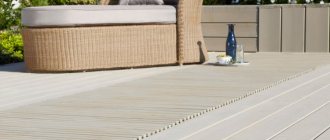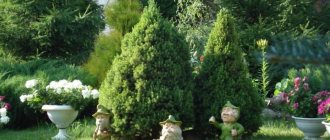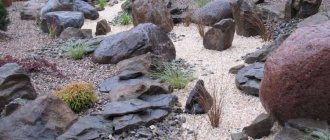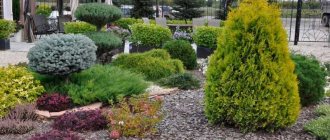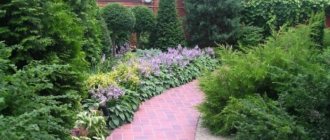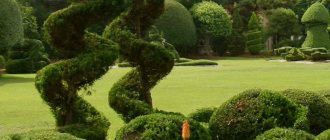Setting up rockeries (rock gardens) can seem like a daunting task. It requires a lot of physical work and planning. A popular type of rock garden is a rock garden. To create a beautiful design, you need to follow a few rules. When choosing plant species for a rock garden, it is necessary to take into account the degree of exposure to the sun in certain places and the level of soil moisture. Many gardeners are guided by a color palette when choosing perennial plants, selecting flowering dates, ensuring continuous flowering of rockeries. We will tell you what requirements you need to adhere to and what are the best plants to plant for an alpine hill with photos of interesting solutions.
Main selection criteria
When choosing plants for an alpine hill, it is recommended to pay attention to the following key criteria:
- Location of the rock garden. It is recommended to choose sun-loving plants if the structure is located in the sun. For a slide placed in the shade, shade-tolerant specimens are more suitable.
- Duration of flowering. Plants that bloom for a long time are more suitable for a rock garden, since they allow you to maintain the decorative appearance of the hill from spring to late autumn.
- Aesthetic color compatibility. It is desirable that the selected specimens match each other in shape, shade of leaves and flowers.
- Individual needs of plants. Before planting, it is recommended to study the requirements of the selected specimens for soil type, humidity and lighting.
Where is the best place to place an alpine slide?
The place where the rock garden will be placed must be sunny and located in plain sight. It is better to build a slide on a natural hill, but if the terrain is flat, you will have to create a solid foundation. In order for the structure to look natural and fit harmoniously into the surrounding space, it should be allocated enough space (at least 2.5 x 1.5 meters).
A good addition to the mountain landscape would be a small artificial pond, a stream or even a waterfall, a path made of flat stones and simple plaster sculptures.
Recommendations for placing plants in rock gardens
A successful combination of plants in a rock garden
It is recommended to plant plants in rock gardens in tiers so that they look harmonious. It is advisable to plant moisture-loving and shade-tolerant specimens at the foot of the hill. In this place, cereal plants and saxifrage take root and look good. On the middle tier it is recommended to place specimens that can easily tolerate a lack of lighting (lumbago, primrose). Sedum can be planted in the gaps between upright growing plants. On the upper tier it is advisable to place perennials and annuals, for example, Iberis. To make the alpine hill brighter, you can add creeping thyme to its top. It goes well with rock alyssum, which has yellow flowers.
Plants in rock gardens should be arranged in tiers
Small trees and tall plants are recommended to be planted first at the foot or in the background. They look good near large stones. It is recommended to separate the tiers with low-growing specimens or stones.
Photo: approximate color schemes
Tall plants and trees are recommended to be placed in the background
A perennial herbaceous peony looks good on the top tier
Herbaceous plants and shrubs, such as thyme and plantain, are best placed at the foot of the rock garden
Suitable plant species with photos and names
The following plant species are suitable for growing in rock gardens:
- perennials (herbs and flowers);
- ground cover;
- creeping;
- shrubs;
- bulbous;
- conifers.
Perennials have a slow growth rate. So that the area does not just sit idle, it can be decorated with annual plants.
Perennials
Perennials most often occupy most of the alpine hill. They have a number of the following weight advantages:
- long flowering period;
- ease of care;
- drought and frost resistance;
- high density of inflorescences.
The following perennials are great for decorating an alpine hill:
- Carnation. These perennials are distinguished by lush flowering. First, it is recommended to plant carnation grass, and in the summer add pinnate and alpine species to them.
- Echinacea. This perennial has large and bright flowers. It blooms in mid-summer, replacing plants that have already bloomed by this time.
- Primorskaya army. The plant is a decorative long-flowering spherical bush.
- Alyssum rocky. The perennial forms lush inflorescences. Its flowers are golden in color.
- Rejuvenated (stone rose). The advantage of this plant is that it can grow stronger even in narrow crevices of stones. Stone rose is also distinguished by a variety of flower shapes and colors.
- Edelweiss (highlander). The perennial looks great on the top tier of the rock garden.
- Crimson arena. This specimen is capable of growing not only on sand, but also on stones. In addition, Arenaria is long-flowering and pleases with its beautiful inflorescences throughout the summer.
- Rhodiola. The plant is also distinguished by long and lush flowering. Rhodiola blooms from spring to autumn.
Video: review of unpretentious perennials
Ground cover
Ground cover plants perfectly fill the foot of an alpine hill and decorate it. Most of these specimens have small flowers, and some of them do not have them at all. At the same time, ground cover plants have beautiful foliage. Flower growers should pay attention to the following specimens from the list:
- Saxifrage. The plant grows quite quickly, covering large areas of the alpine hill with a “carpet”. There are about 400 varieties of saxifrage, distinguished by interesting flower colors.
- Arabis (rezuha). This plant is considered a universal shade-tolerant ground cover for rock gardens. In a well-lit place it blooms more profusely, and in the shade it forms more leaves.
- Sedum. Both the herbaceous and bushy forms of this ground cover plant are suitable for decorating a rock garden. It can grow in both shade and sun.
- Iberis. The flowering period of this plant begins in mid-spring. At this time, Iberis forms lush caps consisting of small flowers.
Photo: interesting ground cover plants
Small snow-white saxifrage flowers will decorate the foot of the rock garden
Arabis forms a beautiful “carpet” in the rock garden
Sedum is not only decorative, but also unpretentious
Thanks to the blooming iberis, it seems that the alpine hill is covered with snowdrifts
Creeping
At first glance, creeping plants and flowers for an alpine hill are no different from ground cover. These species do share common characteristics, such as poor flowering and short stature. But unlike ground cover, creeping specimens can cover a much larger area of the rock garden with their vegetation, since their shoots practically lie on the ground. This quality is especially important for the design of alpine slides, in which the flowers have limited access to the soil due to stones. Creeping plants are great for decorating the base.
Creeping specimens can partially or completely entangle large stones, helping to create an interesting composition.
On the lowest tier of the rock garden you can place the following creeping plants:
- Periwinkle. The plant grows rapidly, covering the area with beautiful blue-violet flowers.
- Thyme. This specimen is a subshrub reaching a height of 30 cm. The florist will need to remove standing shoots in a timely manner so that its height is small.
- Euonymus. In nature, it is most often found in coniferous forests and therefore it is recommended to plant it in rock gardens next to conifers.
Photo: creeping species for rock garden
On the sunny side, euonymus quickly grows in width, which allows it to be used as a cover plant.
Barvino weaves its green mass into the cracks between the stones and decorates the rock garden with small purple flowers
Purple and pinkish thyme flowers can cover rocks in a rock garden.
Conifers
Conifers can be combined with any other species, creating a contrast in color and shape. The following types of conifers are suitable for a rock garden:
- western thuja;
- Canadian spruce;
- Korean fir;
- dwarf Norway spruce;
- juniper.
You should not use pruned tall trees to decorate a rock garden. It is recommended to plant only dwarf varieties whose height does not exceed 70 cm.
Photo: dwarf varieties of conifers
You can place several western thujas in a rock garden at once
Canadian spruce is best planted in the background of a rock garden
Shade-tolerant juniper with bluish-green needles will create an interesting contrast in the created composition
Low-growing Korean fir will decorate an alpine hill
The pearl on the alpine hill will be a dwarf Norwegian spruce
Bulbous
Bulbous plants are quite demanding on the composition of the soil. For this reason, it is recommended to choose varieties that can grow in sandy soil or plant them in areas with loose soil. The following types of bulbs are suitable for decorating an alpine slide:
- muscari;
- hazel grouse;
- Pushkinia
Photo: varieties of bulbous flowers
Muscari stands out against the background of other plantings
Grouse, distinguished by variegated flowers, will decorate any rock garden
Pushkinias bloom in early spring and complement other plants well.
Shrubs
It is recommended to place shrubs on slopes and at the foot of an alpine hill. Such plants harmonize perfectly with ground cover and creeping species. Only low-growing specimens should be planted. The following varieties of shrubs will look good in a rock garden:
- Thunberg barberry;
- cotoneaster;
- rhododendron;
- hydrangea;
- mock orange
If you plan to plant several shrubs in the rock garden, then you should choose 2-3 representatives of the same family.
Photo: the best types of shrubs
Barberry Thunberg is an ornamental and unpretentious shrub
Rhododendrons in rock gardens help eliminate the monotony that occurs when planting only low-growing herbaceous plants
Cotoneaster is a deciduous shrub that can decorate a rock garden with bright red berries.
Mock orange stands out for its snow-white flowers, which have a pleasant aroma
Hydrangea will decorate any alpine hill with its lush inflorescences
Annuals
Annual plants go well with bulbous plants. Flower growers are advised to pay special attention to climbing species of annuals. The following specimens will help give the alpine hill a natural look and place accents:
- lagurus (haretail);
- morning glory;
- bindweed tricolor;
- emarginate dimorphotheca;
- Perovsky's jaundice;
- lobelia;
- dorotheanthus.
Photo: decorative annual specimens
Notched dimorphotheca stands out among other plantings due to its bright and large flowers
Curly morning glory purple will be a real highlight of any alpine hill
The bright inflorescences of jaundice are not only decorative, but also have a pleasant aroma.
Dorotheanthus is recommended for rock gardens in the southern regions
Lagurus is an unpretentious and drought-resistant annual
Tricolor bindweed will become a bright accent in the garden rock garden
Lobelia is distinguished by its unpretentiousness and variety of varieties
Spicy and aromatic on a hill
There are a number of plants that do not attract the beauty of their flowers, but their foliage makes beautiful rugs and pillows, and their wonderful healing aromas and properties are used in both cooking and medicine.
Sagebrush
Dwarf varieties of this plant do not exceed 10 cm, and the silvery foliage turns out to be indispensable for giving the hill sophistication.
Compactness is created by annual pruning, and the plant is planted in spring or autumn.
Tips and reviews from experienced gardeners
The basis of my alpine slide is clay left over from digging a well. There is a plus in it - it restrains the rapid growth of conifers and shrubs, keeps them within certain limits, so to speak. The assortment of my “upper” tier (everything has passed the test of time and various winters): mountain pine, lavender, fescue, bearded dwarf iris, many young plants of various varieties, sedum, subulate and spreading phlox, saponaria (soapwort) - the simplest, creeping, on one of the tops sits a barberry of an unknown variety from a box indicating the size of 40–170 cm, spreads a little, does not want to grow in height at all - in 5 years it has never frozen, conika spruce and blue dwarf juniper - do not burn at all, do not freeze and do not dry out.
mogileva
https://www.websad.ru/archdis.php?code=390019
In summer my alpine slide looks no worse than in spring. True, the colors are a little less, but there are a lot of green mats and all kinds of decorative foliage: tenacious, sedge, heuchera, sedum, cineraria, bergenia, juvenilia, thyme, juniper, woolly cherry, etc. The ground cover rose has grown very well. It blooms profusely, brightly, and is pleasing to the eye. Carpathian bluebells are also blooming. So the slide constantly changes colors and does not lose its decorative effect. Of course, provided that all protruding and faded, dry flower stalks (sedum, tenacious, edelweiss, etc.) are constantly removed.
Yulichka
https://www.websad.ru/archdis.php
The plant is ideal for a rock garden on the southern side - Armeria. It's blooming now. Grows without problems. In order not to disappear, the main thing is to divide it in time. It doesn’t grow in my rock garden, but I try to keep it dry and add sand and pebbles. Yaspolka and sysyurynchia can also be identified there. Yaskolka grows remarkably, covering large areas. Reacts calmly to trimming and removing excess.
LenaMir
https://forum-flower.ru/showthread.php?t=1247
For an alpine hill I can offer Turkish carnation, young or stone rose and periwinkle. All flowering plants. There are many varieties of cloves, I have three types. The stone rose produces arrows, and pink flowers bloom on them, very beautiful. Well, periwinkle, as far as I know, has at least two types, and blooms around May with blue flowers.
Vitalinka
https://honeygarden.ru/viewtopic.php?t=159
Stylistics and rules for selecting plants for rocky gardens
Before you decide what to plant on your alpine hill, figure out which style you prefer. In the arrangement of “rock gardens” it is customary to distinguish several directions.
- European, also known as Alpine style. Its main feature is the demonstration of the beauty of plants. The stone serves as a kind of frame for them. The basis of the slide is alpine high-mountain flora, but ornamental plants from the middle zone are also appropriate. Trees, perennials, and flowers are selected in such a way that the rock garden pleases the eye with bright colors all season long.
- In English rock gardens, motifs of the Alpine style can be traced, but they are closer to the environment. Coniferous trees and shrubs, cereals, wormwood, and heathers are welcome in the design; the color scheme is all shades of green. The aesthetic principle comes first, when the beauty of the landscape is more important than botanical authenticity.
- In our cold latitudes, the climatically consonant Scandinavian style is popular. It is inherently decorative. The minimalism of vegetation (conifers, ground cover, mosses) is compensated by figurines, original figures made from natural materials, stone-paved areas and paths.
- On an oriental-style alpine slide, the emphasis is transferred from vegetation to stone and water. The size, shape, and arrangement of boulders are given a special meaning, the composition is filled with allegories, and the task of plants is to emphasize and strengthen them. In an emphatically neat and well-groomed natural corner there is no room for accidents, every detail is thought out, the plants carry a symbolic meaning.
- A Chinese-style slide is unthinkable without water. An artificial pond, a fountain, a stream with an openwork stone bridge, an island covered with vegetation - these elements will give the rocky area a special flavor, and the water will create the illusion of peace and eternity.
General approaches to plant selection
The classic version of vegetation for a rock garden is high-mountain alpine flora. Owners of collection gardens strive for such compliance. The flower requirements for a country alpine garden made in a free style are much more democratic - these can be perennial and annual plants, wild and decorative forms, in the same style or fantasy direction. But some general approaches exist.
- The traditional botanical set for an alpine hill is low-growing trees and shrubs, occupying no more than ⅓ of the area, creeping plants, perennial flowers and herbs, early flowering bulbous plants.
- Trees and shrubs should be low, with an unusual crown shape, slow-growing, and frost-resistant.
- The basis of an alpine slide is ground cover plants that form a multi-colored carpet or compact pillows between the stones.
- Conventionally, an alpine hill is divided into several zones - on the top and improvised slopes, and drought-resistant and light-loving plants are planted on the sunny side. At the foot, on the northern shaded side, trees and shrubs, moisture-loving perennials with decorative foliage are placed.
- Lush thickets are not welcome. A rocky frame for plants is like a frame for a picture. It is designed to convey the refined beauty of modest, at first glance inconspicuous flowers, to give the opportunity to admire their perfection.
Important! If you want your slide to match the alpine style as much as possible, give up flowers in favor of plants, for each of which create a microlandscape that is close to the natural growing conditions. Plant saxifrages in crevices and splits of stones, carnations - on dry scree of slopes, edelweiss and bells - in improvised valleys with nutritious soil.
